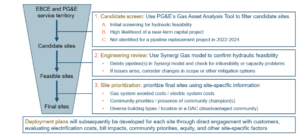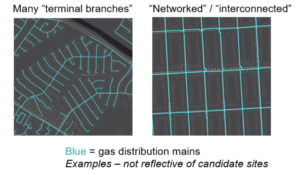Selecting Gas Decommissioning Pilot Locations
Introduction
This blog post outlines the proposed gas decommissioning site selection framework for the Northern California portion of the California Energy Commission’s (CEC) Tactical Gas Decommissioning Project. You can read more about the scope of this project and organizations involved in our prior blog post here.
This project’s primary objective is to address the following question: How can targeted electrification paired with tactical gas decommissioning provide net gas system savings, while promoting equity and meeting the needs of local communities?
Proposed Site Selection Framework
To date, Pacific Gas and Electric (PG&E) has implemented over 80 small gas decommissioning projects, focused mainly on the higher-pressure gas transmission system, where the number of affected gas customers has been small (less than 10 customers at a time), and where significant operations and maintenance expenses can be avoided through decommissioning. For this study, our project team decided to focus on tactical decommissioning opportunities on PG&E’s lower-pressure gas distribution system for two reasons:
- Potential for scale: Most retail customers are connected to the distribution system, so most of the potential for targeted decommissioning is on the distribution system
- Potential for cost reductions: Anticipated retail gas cost challenges from building electrification largely concern cost recovery from the distribution system
The team is developing a framework for identifying and prioritizing sites for targeted electrification and tactical gas decommissioning projects within PG&E’s gas distribution system. A version of this framework is being applied to locations in the shared service territory of PG&E and East Bay Community Energy (EBCE). The framework will be used to identify three pilot projects for which implementation plans will be developed.
PG&E’s Gas Asset Analysis Tool
The pilot selection framework leverages an existing gas distribution spatial analysis tool developed for PG&E’s internal use, which E3 was able to access under a non-disclosure agreement (NDA) with PG&E. Since many types of customer data and detailed infrastructure data are considered confidential or sensitive in nature, E3 will only be sharing aggregated results from the PG&E Gas Asset Analysis Tool, ensuring the protection of sensitive and confidential information.
Draft Pilot Selection Framework
The following figure shows a proposed three-step framework for identifying sites for targeted electrification and tactical gas decommissioning projects.
Figure 1. Draft framework for Identifying Potential Gas Decommissioning Projects
 Step 1: Screen for Candidate Sites
Step 1: Screen for Candidate Sites
The first step of the proposed pilot selection framework involves identifying candidate sites where a utility could potentially avoid a gas pipeline replacement project through gas decommissioning. This more limited number of locations is then provided to the utility for review and confirmation of preliminary results. This screen includes three components which are explained in greater detail below.
Hydraulic Feasibility
PG&E must be able to remove gas pipelines from service without impacting safety and reliability. Decommissioning projects that can be implemented without negative impacts on the gas system are “hydraulically feasible.” The hydraulic feasibility of a given project cannot be conclusively determined until PG&E completes a detailed gas engineering review of the proposed site. To provide PG&E with a practical number of potential locations to review, the project team selected for “terminal branches” of the gas distribution system, i.e., sites that lie on radial portions of the distribution system and have no downstream customers. These sites are extremely likely to be hydraulically feasible.
Working inward from the end of a radial portion of the system, “terminal branches” of different sizes can be identified. At large enough scale, entire neighborhoods could be considered “terminal branches” if hydraulically independent from other parts of the distribution system, meaning those pipes are not interconnected with many other points in the system. For the purposes of this project, sites of up to a few hundred customers were identified, with the potential to narrow the site to fewer customers in a future step.
Under the initial “terminal branches” screening step, no non-residential candidate sites were advanced within PG&E and EBCE’s shared service territory. The project team had a goal of evaluating a diverse mix of buildings for potential gas decommissioning pilots, including some sites with non-residential buildings, so the project team subsequently relaxed this approach and advanced a few sites in “networked” segments of the system that do include non-residential buildings. We will share more on findings from applying this framework to specific sites in a future blog post.
See the following figures for examples of terminal branches and networked segments.
 High likelihood of a near-term capital project
High likelihood of a near-term capital project
The second part of the candidate screen involved identifying pipeline segments with a high likelihood of near-term capital projects, as these would likely provide the greatest opportunity to avoid investment in gas infrastructure, and ideally to generate gas customer savings. Currently, PG&E does not plan pipeline replacement projects beyond the 3-year General Rate Case (GRC) cycle. Thus to forecast the potential for capital projects beyond that three-year period, the project team has used a PG&E-developed GIS data layer that considers characteristics including pipeline age, pipeline material, and other factors as a proxy for pipelines with a high likelihood of a near-term capital project.
Not identified for a gas pipeline replacement project in 2022-2024
PG&E has already planned a number of pipeline replacement projects through 2026, corresponding to the three-year planning cycle and the 2020 and 2023 GRCs. The project team recognizes that achieving full electrification of a pilot site will potentially take multiple years. For this reason, the proposed selection framework excludes sites where the pipelines are likely to be replaced, primarily for safety reasons, before a gas decommissioning alternative project could proceed.
Step 2: Utility Gas Engineering Review
PG&E gas engineers use DNV-GL’s “Synergi Gas” model to plan the gas distribution system. This tool is also used to evaluate hydraulic feasibility for gas decommissioning. At a high level, engineers reviewing a gas decommissioning site perform the following steps:
-
- Delete the pipeline(s) under consideration for decommissioning
- Re-run the Synergi model
- Check for
A) Infeasibility (e., stranded customers outside of the decommissioning project) or
B) Capacity issues (e., pipelines falling below minimum pressure ratings)
If neither (A) nor (B) occurs, the project is feasible. If (A) or (B) occurs, the decommissioning scope must be changed and/or mitigation strategies must be evaluated such as adding new gas mains or regulators to the system.
Step 3: Site Prioritization
The final step in the proposed selection framework entails using more detailed site-specific information to prioritize sites for gas decommissioning projects. In this CEC-funded study, the project team will ultimately advance three pilot sites. The team will then work with local community-based organizations to engage with community members from each site to ascertain, and ideally to achieve, some level of community support for the project. Finally, the project team will develop deployment plans for the three pilot sites. Outside of this CEC research grant, utilities, policymakers, and stakeholders may find this final site selection step useful to the extent that future projects will also need to prioritize potential gas decommissioning sites in light of funding and resource constraints.
Gas System Avoided Costs and Electric System Upgrade Costs
Developing a framework and understanding of gas system avoided costs is fundamental to achieving cost savings from targeted gas decommissioning. Gas system avoided costs reflect avoided pipeline replacement costs, plus avoided operations and maintenance costs, minus any incremental decommissioning costs. Public data on these costs is very limited and the project team is working with PG&E to develop cost estimates for each of these categories. Under current funding paradigms, PG&E and other California gas utilities are not able to utilize authorized gas capital budgets for electrification efforts.
The project team also plans to include electric system upgrade costs in site selection. Although these costs may be incurred in the future regardless of the decommissioning project, the timing of electric system upgrades may have an impact on near-term electric rates.
Community Priorities / Presence of Community Champion(s)
Decommissioning gas distribution pipelines will result in PG&E gas customers being disconnected from gas service and provided with all-electric alternatives. While some customers may be excited to participate in an electrification program, other customers may not be enthusiastic. This could be due to limited familiarity with all-electric appliances, concerns regarding bill increases, interest in retaining gas cooking, or other reasons. The project team believes that electrification, especially if coupled with efficiency improvements, can bring benefits for PG&E and EBCE’s shared customers in terms of potential energy bill savings, comfort, and indoor air quality. However, it will be crucial to ensure that electrification is aligned with community priorities where these decommissioning projects take place. Communities with an existing champion for electrification may have greater likelihood of successful community engagement. These community champions could be supportive municipal governments, community-based organizations, and/or civic leaders.
Next Steps
In the coming weeks, the project team intends to release a series of blog posts. These will include preliminary high-level results from applying the site selection framework, lessons learned to date, and progress on community engagement. We also plan to host a public workshop in the fall.



